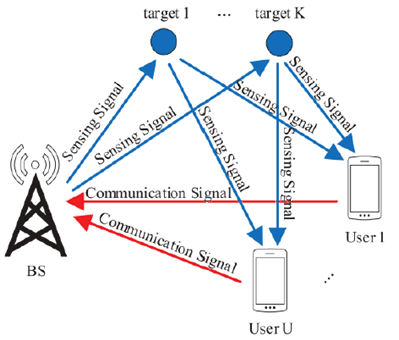Content for TR 22.837 Word version: 19.3.0
0…
4
5…
5.2…
5.3…
5.4…
5.5…
5.6…
5.7…
5.8…
5.9…
5.10…
5.11…
5.12…
5.13…
5.14…
5.15…
5.16…
5.17…
5.18…
5.19…
5.20…
5.21…
5.22…
5.23…
5.24…
5.25…
5.26…
5.27…
5.28…
5.29…
5.30…
5.31…
5.32…
6…
7…
5.4 Use Case on Transparent Sensing Use Case
5.4.1 Description
5.4.2 Pre-conditions
5.4.3 Service Flows
5.4.4 Post-conditions
5.4.5 Existing feature partly or fully covering use case functionality
5.4.6 Potential New Requirements needed to support the use case
...
...
5.4 Use Case on Transparent Sensing Use Case p. 21
5.4.1 Description p. 21
In general, a UE senses using either or combination of the non-3GPP sensors such as camera, Lidar, 3GPP-based sensing. In 3GPP 5G wireless sensing, the Sensing transmitters and Sensing receivers sense for stationary and moving Objects around them - using time-difference-of-arrival (TDoA), angle-of-arrival (AoA), angle-of-departure (AoD) measurements, RSSI etc. as shown in Figure 5.4.1-1 [14]. Transparent sensing is a use case in which 3GPP sensing data is captured by Sensing transmitter and/or Sensing receiver and communicated so that the 5GS is aware of the 3GPP sensing data, while the non-3GPP sensing data is the result of non-3GPP sensors and is transparent to 5GS. From this information, service enablers can be defined. One example of such information is location data, whose corresponding service enabler is Location Based Services.

In this use case, non-3GPP sensing data is made available to the 5GS, and the requirements for this exposure are considered. The data so obtained can be used for diverse purposes. One such purpose is Localization (identifying both a three- dimensional position and orientation.) Transparent Sensing data used for Localization is described in TR 22.856.

The distinguishing characteristic of this use case is that the non-3GPP sensing data is provided to the 5GS itself.
The application server receiving 'transparent non-3GPP sensing data' as shown in Figure 5.4.1-2 can be operated by the MNO. This enables the MNO to provide specific processing to produce 'combined sensing results as a service,' where the sensing data is supplied by non-3GPP sensors owned and operated by third parties, subscribers, etc.
In this use case it is the 5GS that receives 3GPP and non-3GPP sensing data, not a third party.
5.4.2 Pre-conditions p. 22
A UE has access to one or more sensors. In this use case. the UE has access to four sensors: NR-based sensing, 3D LiDAR, an RGB Camera and a Smart Phone Camera. The sensors' physical configuration is known (e.g. the cameras are 10 cm apart). The NR-based sensing capabilities of the UE and its connected BS are used to capture information about the nearby environment by the UE.
A mobile network MN supports the acquisition of non-3GPP sensing data. We term this support by the network a 'non-3GPP sensing data consuming service'.
5.4.3 Service Flows p. 23
The user U activates a mechanism to enable Non-3GPP sensing data acquisition that can be collected at U's UE.
The user U provides this non-3GPP sensing data via the 5GS. This process is analogous to activating or enabling a location tracking service.
MN acquires sensing data provided by U's UE, for a period of time.
MN can also acquire 3GPP sensing data. 3GPP-RF sensing data can be processed only in 5GS to derive sensing results. The sensing results and the Non-3GPP sensing data can be combined to produce a combined sensing result.
The user U deactivates the mechanism to provide non-3GPP sensing data to the 5GS.
5.4.4 Post-conditions p. 23
The non-3GPP sensing data acquired by the 5GS is processed in order to enable other services. The processed information can for example provide 'Spatial Localization' information that can be exposed to authorized third parties, as discussed in TS 22.856. "Spatial Localization Use Case".
5.4.5 Existing feature partly or fully covering use case functionality p. 23
Positioning in 5G Networks been proposed in 3GPP release-16, it specifies positioning signals and measurements for the 5G NR. In release-16, 5G Positioning architecture extends 4G positioning architecture by adding Location Management Function (LMF) and Transmission reception points (TRP). 5GS provides new positioning methods based on multi-cell round-trip time measurements, multiple antenna beam measurements, to enable downlink angle of departure (DL-AoD) and uplink angle of arrival (UL-AoA) [15] [16]. The Rel-17 5G system supports positioning of the device-based but not device-free - objects that do not radiate EM signals [14] [15] [16].
The 5GS already supports transport of non-3GPP sensor data. The Table below provides indicative performance requirements for media used for sensor information communication.
| Sensor Type | Uplink KPI | Remarks |
|---|---|---|
| 3D Lidar | 30 Mbps | An example 3D LiDAR: 16 channel, 0.3M data points, dual return mode 2 bytes distance, 1byte [13] |
| Industrial RGB Camera | 16 ~ 800 Mbps | 2,592 x 2,048 x 10bits x 2.5 Hz x 6 EA, compression ratio 2% |
| Smart Phone Camera | 4 ~ 200 Mbps | 2,160 x 2,880 x 8bits x 1 Hz x 4 EA, compression ratio 2% |
5.4.6 Potential New Requirements needed to support the use case p. 23
[PR 5.4.6-1]
Subject to user consent and national or regional regulatory requirements, based on operator policy, the 5GS shall support a mechanism to receive uplink non-3GPP sensing data from authorized non-3GPP sensors.
[PR 5.4.6-2]
Subject to user consent and national or regional regulatory requirements, based on operator policy, the 5GS shall support a mechanism to expose sensing results to trusted third parties.
[PR 5.4.6-3]
Subject to user consent and national or regional regulatory requirements, based on operator policy, the 5GS shall support a mechanism to expose combined results to trusted third-parties.
[PR 5.4.6-4]
Subject to user consent, network operator policy and national or regional regulatory requirements, the 5GS shall support a mechanism to enable Sensing transmitters and Sensing receivers to acquire 3GPP sensing data to capture information about the nearby environment and for this to be combined with Non-3GPP sensing data to produce a combined sensing result.